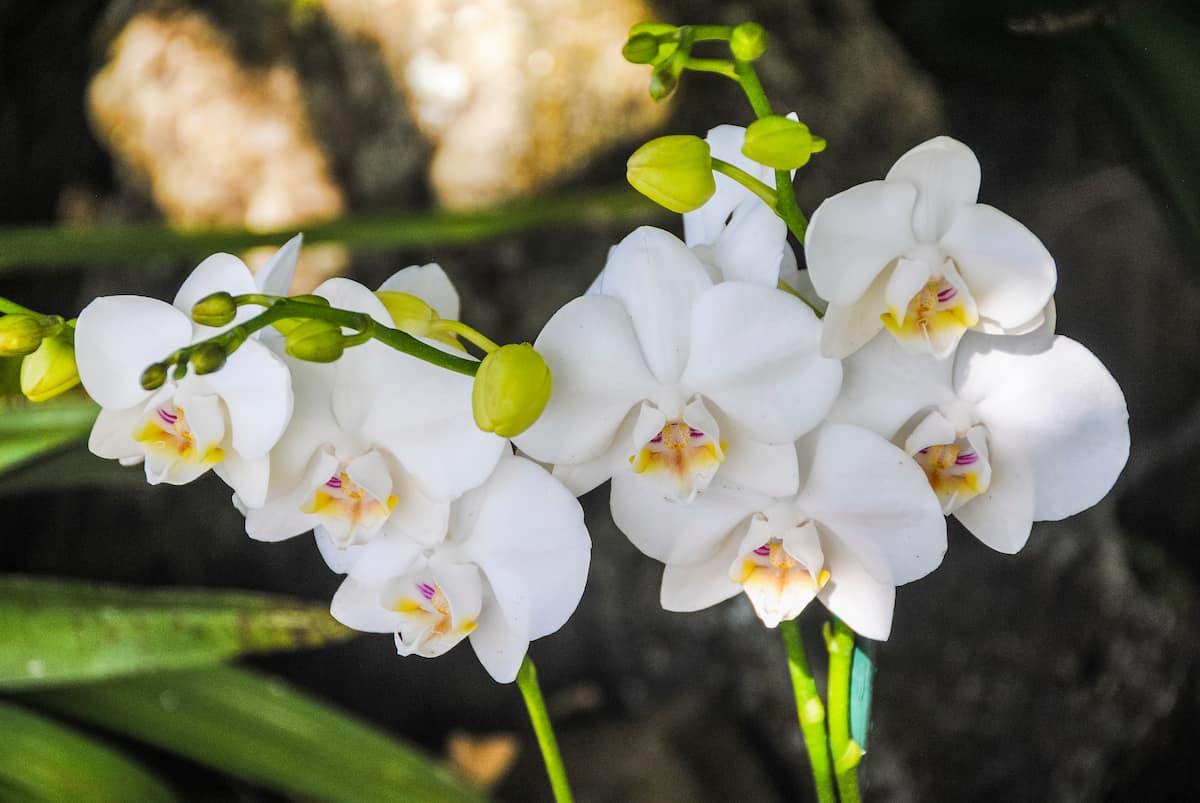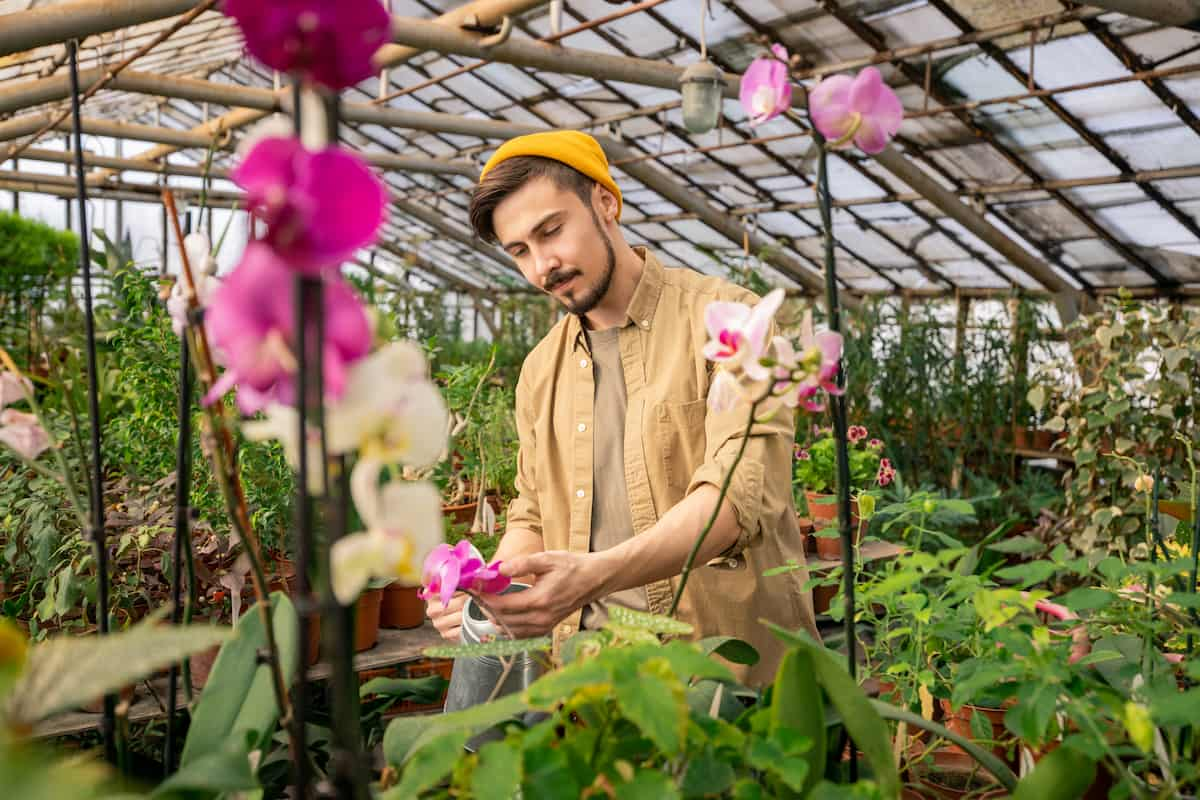The orchid plant is one of the most beautiful plants but is also known as one of the most difficult to grow. All they need are the right conditions. When you grow orchids in a greenhouse, you can control them as much as possible, making the process much easier than growing them outside. With an orchid greenhouse, you can mimic the natural environment of the orchid and control its growth.

How to Grow Orchids in a Greenhouse
Orchid Varieties Suitable for Growing in Greenhouse
Choosing commercially available orchids is a good idea if you’re a beginner orchid grower. They’re not only less expensive but also easier to grow and care for. The following are some varieties of greenhouse orchids:
- Phalaenopsis (Moth Orchids)
- Cymbidium
- Cattleyas (Corsage orchid)
- Paphiopedilums (Slipper Orchids)
- Laelias
Growing Media for Orchids to Grow in Greenhouse
A healthy root system is the key to growing any plant; orchids are no exception. It is best to trust professionals to provide the correct growing medium for beginner orchid growers. Orchid potting mix is specifically designed for orchids and other epiphytes like bromeliads and anthuriums. It is composed of chunks of coconut husk and western bark. A limestone supplement has been added to the mix, giving it the proper pH balance for healthy growth. The plant’s roots can absorb air and water since this formulation does not compact.
Lighting Requirements for Growing Orchids in Greenhouse
The majority of orchids require bright, indirect sunlight. It is important to remember that they prefer to grow on trees where they can benefit from shade but still receive indirect light from the foliage. In contrast, some orchid varieties like Vandas and Epidendrum require direct sunlight.
Therefore, you should always check the specific requirements for your variety of plants. However, the leaves of orchids should not be exposed to direct sunlight, as it may scorch and damage them. You should move your orchid to a new location and avoid cutting the burnt leaves until your orchid grows new, healthy leaves.
Temperature Requirements for Growing Orchids in Greenhouse
You must provide orchid plants with the appropriate temperature in your greenhouse if you want them to grow healthy. With any orchid variety, a constant temperature range is unnecessary all day. The best conditions for growing orchids are when the daytime temperature ranges between 16-27°C and the nighttime temperature drops to around 7-18°C. Depending on the orchid variety, some will not bloom unless the temperature drops at night.
How to Grow Orchids in Greenhouses
- Choose pots that are the right size and shape for your orchids. Ensure the pots are shallow, squat, and have good drainage holes so excess water can drain out. Pots that are too deep tend to retain too much moisture, which is not good for orchids.
- The next step is to fill your pot halfway with an orchid potting mix. Regular soil is not suitable for growing orchids. The orchids should be gently placed in the soil, and the soil should be filled up to the top of them. Pack the potting mix firmly around the orchid to keep it upright.
- Fertilize your orchid plant with a general-purpose fertilizer or a specialized orchid fertilizer. The majority of garden supply stores carry these.
- A strong, fleshy root system will develop as the orchid grows in your greenhouse. It is necessary to repot orchids when their roots become too large for their pots (but not too big, since orchids prefer contained spaces).
- Follow the regular planting procedure when repotting your orchids. To improve drainage, you can place pebbles or rocks at the bottom of the pot. As orchids are very sensitive, do not repot them frequently.
In case you missed it: How to Grow Geranium in a Greenhouse: A Step-by-Step Guide for Seed to Harvest

Watering Requirements for Growing Orchids in Greenhouse
Humidity is ideal for orchids, but overly wet or soggy soil will cause their roots to rot very quickly. As a thumb rule, water orchids once every two weeks during the winter and once a week during the summer. Always water orchids sparingly; don’t let them sit in water for long periods. However, take care. It can cause leaf discoloration and the dropping of orchids if you scarcely water them. The orchid prefers to dry out between waterings. Your orchid may need water when your finger is buried in the soil if it feels dry. It’s probably time to water.
Fertilizing Orchids Growing in Greenhouse
Fertilizer is not necessary for orchids to grow and bloom. You can, however, provide essential nutrients to your plant by feeding it. Orchids should be fertilized at least once a month, according to experts. During the third watering in the growing season, feed your orchids a weak solution of balanced plant fertilizer. You can skip watering on days/weeks you will be fertilizing because you will need to dilute your fertilizer with water. When fertilizing, stay away from the leaves. A narrow-spouted watering can is ideal for this purpose.
Pruning Orchid Plants Growing in Greenhouse
After blooming in spring and summer, orchids enter a resting period in fall when their flowers wilt and drop. Pruning and cleaning your orchids during bloom loss is the best time. Orchids can benefit from pruning to promote new growth. The process of pruning orchids can be intimidating if you are a beginner. The first step is to prepare your tools. When using pruning shears, ensure they are sterilized and cleaned with rubbing alcohol before and after each use. Trim spikes just above nodes for healthy, green spikes. There will be an increase in blooming in that area as a result.
Common Pests and Diseases in Orchids
Growing these plants in a greenhouse may be more problematic due to insects. Be on the lookout for scale, aphids, mealybugs, and spider mites. You can prevent an infestation by washing your leaves regularly. Pest infestations that cannot be managed through leaf washing can be killed by neem oil.
Cymbidium mosaic virus and Odontoglossum ringspot virus are the most common viruses to watch out for. Both of these viruses cannot be cured, so prevention is key. The best way to control disease spread is to follow hygiene practices like washing your hands after handling different plants and sanitizing your tools. It is possible for infected plants to show no signs of illness, so make sure to use good hygiene between handling different plants, even if they seem healthy.
Harvesting Orchids
There is a tendency for flowers to perish easily, and they are generally fragile. With the correct harvest and post-harvest handling procedures, the grower ensures a clean and quality crop and prolongs the blooming period. During harvest, sterilize equipment to prevent premature petal drops and bacteria from spreading. Harvesting time depends on the growth stage of the plants, but it can also be affected by market demand.
Only 3 or 4 days after opening, an orchid flower is fully mature. Whenever possible, flowers are harvested when they are fully open, as flowers cut before maturity will wilt before they reach wholesalers. A fresh tube containing preservative water is inserted into the flower after harvesting by cutting off the lower 0.75cm of the peduncle. It is best to harvest the spike when 75 percent of the flowers are open, and the remaining buds have not opened.
In case you missed it: How to Grow Begonias in a Greenhouse: A Step-By-Step Guide for Seed to Harvest

Conclusion
The conditions in which orchids live can be controlled effectively by growing them in a greenhouse. All the equipment unique to orchid raising in a greenhouse still applies, but because it is enclosed, orchid care can be simplified. A bit of patience and some love for your specimens can bring good health and beauty to your plants.
- Feed Your Flock for Less: Top 10 Tips to Save on Chicken Feed
- Ultimate Guide to Ossabaw Island Hog: Breeding, Raising, Diet, and Care
- Hatching Answers: The Top 10 Reasons Your Chickens Aren’t Laying Eggs
- Eggs and Economics: Breaking Down the Cost of Raising Backyard Chickens
- Defend Your Greens: Proven Methods to Keep Iguanas Out of Your Garden
- Ultimate Guide to Cinnamon Queen Chicken: A Comprehensive Guide for Beginners
- Ultimate Guide to California Tan Chicken: Breeding, Raising, Diet, Egg-Production and Care
- Ultimate Guide to Marsh Daisy Chicken: Breeding, Raising, Diet, and Care
- 10 Types of Chicken Farming Businesses You Can Start for Profits